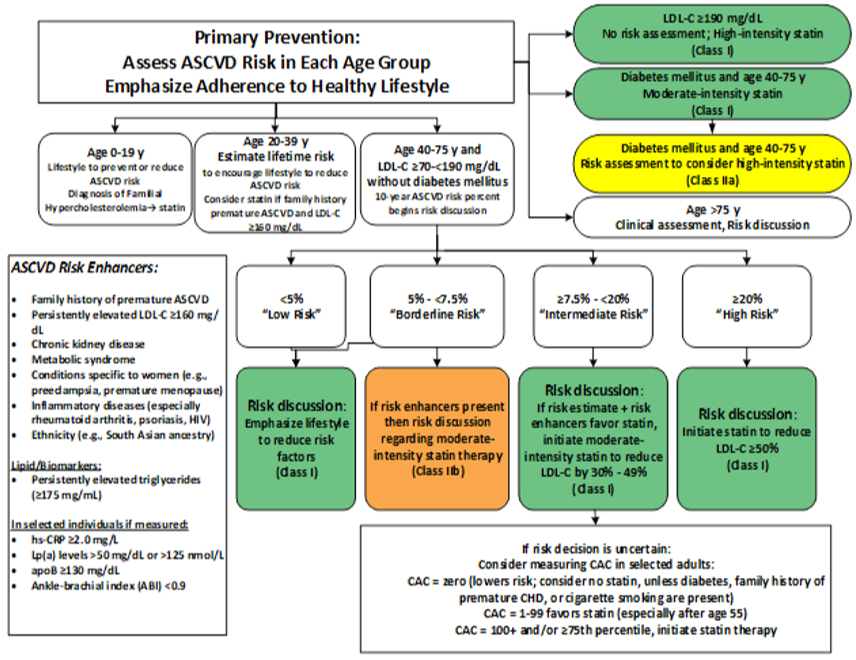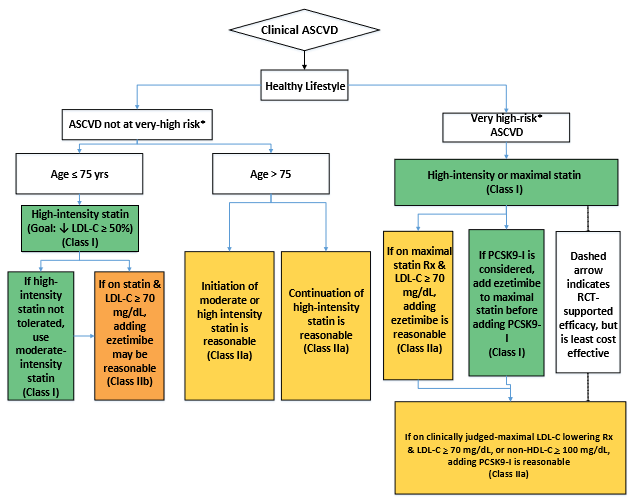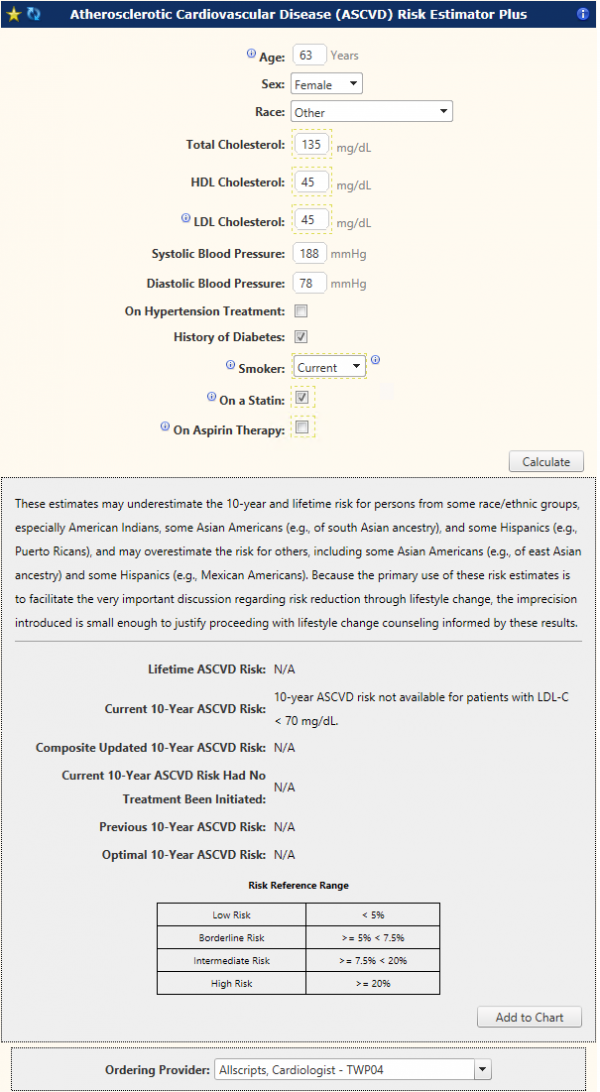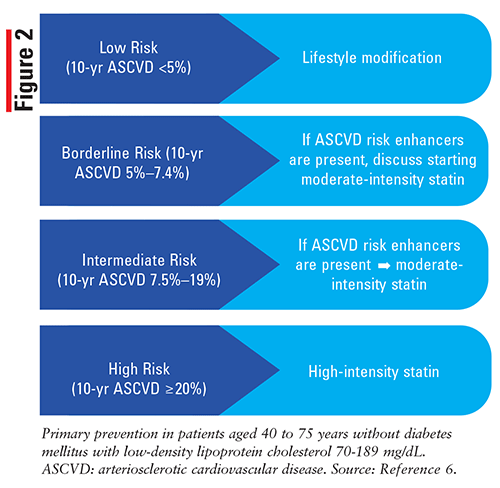10 year risk calculator for ascvd
Py in patients who have additional risk factors or a 10-year risk of an atherosclerotic cardio-vascular disease event higher than 209 Adults age 4075 without diabetes with LDL-C levels 70189 mgdL In this group the guidelines say to use a risk calculator to determine if the patient needs lipid-lowering medication. This calculator helps health care providers to estimate 10-year risk for atherosclerotic cardiovascular disease ASCVD defined as coronary death or nonfatal myocardial infarction or fatal or nonfatal stroke based on the Pooled Cohort Equations.

Cardiovascular Risk Estimation By The Ascvd Risk Estimator Application In A University Hospital International Journal Of Cardiovascular Sciences
In patients with coronary artery disease or whose risk of ASCVD is 10.

. The 10-year ASCVD risk estimator is. 10-year risk for ASCVD is categorized as. For more information about the inputs and calculations used in this app see Terms and Concepts in the Resources tab below.
10-year risk for ASCVD is categorized as. To continue reading this article you must log in with your personal hospital or group practice subscription. For some of the sex-age groups in Framingham the numbers of events are quite small.
Low-risk. One in two for men and one in three for women. This risk score may not adequately reflect the long-term or lifetime CHD risk of young adults which is.
The values for the actual updated 10-year ASCVD risk estimate also have floor and ceiling values applied. Low-risk. 10-year risk of heart disease or stroke.
Patients with low absolute cardiovascular risk 10-year ASCVD risk. 10-year risk for ASCVD is categorized as. These have been compiled in a report and published in a sup.
In adults with diabetes older than 75 years after a patient discussion of potential benefits and risks it may be reasonable to initiate statin therapy. This calculator assumes that you have not had a prior heart attack or stroke. In such patients a blood pressure target of.
IMPORTANT This calculator includes inputs based on race which may or may not provide better estimates so we have decided to make race optional. Low-risk. Low-risk.
10-year ASCVD risk 80 for our patient the role of risk-enhancing factors benefit vs risk for lifestyle changes and medications concerns about cost or other worries as well as patient concerns and preferences. For more information about the inputs and calculations used in this app see Terms and Concepts in the Resources tab below. 1 Patients are considered to be at elevated risk if the Pooled Cohort Equations predicted risk is.
The floor value is calculated as the predicted 10-year ASCVD risk for someone with optimal risk factor levels at the follow-up age. This calculator is for use only in adult patients without known ASCVD and LDL 70-189 mgdL 181-490 mmolL. Atherosclerotic Cardiovascular Disease ASCVD Risk Calculator.
A patients 10-year ASCVD risk at follow-up will not be calculated to a value below this floor value. Published Nov 2013 Download PDF 2 MB. The risk score can help you make lifestyle changes or take medicines to prevent heart disease.
For more information about the inputs and calculations used in this app see Terms and Concepts in the Resources tab below. It can be considered for patients aged 40 to 59 whose 10-year risk of cardiovascular disease exceeds 10 but absolute benefit is likely to be small. Recommendations for Assessment of 10-Year Risk of a First Hard ASCVD Event.
Informal calculation of lifetime risk of ASCVD for persons. Determines 10-year risk of heart disease or stroke and provides statin recommendations. The Framingham risk score estimates the risk of developing CHD within a 10-year time period.
This peer-reviewed online calculator uses the Pooled Cohort Equations to estimate the 10-year primary risk of ASCVD atherosclerotic cardiovascular disease among patients without pre-existing cardiovascular disease who are between 40 and 79 years of age. These cardiovascular risk assessments use personal health information to calculate a 10-year and lifelong risk of heart disease. Systematic Evidence Review from the Risk Assessment Work Group.
Estimate 10-year risk for atherosclerotic cardiovascular disease. Providers also use the ASCVD Risk Calculator to see how certain treatments might improve your risk status. Cardiovascular risk assessment in adults 10-year ACCAHA 2013 conventional and SI units.
Our ASCVD Risk Algorithm is a step-wise approach for all adult patients including those with known ASCVD. For more information about the inputs and calculations used in this app see Terms and Concepts in the Resources tab below. Cardiovascular risk assessment in adults 10-year ACCAHA 2013 conventional and SI units Close.
All experts involved in the development of these guidelines have submitted declarations of interest. Mayo Clinic Health System in Menomonie offers a Heart Disease Risk Calculator to find out your risk for cardiovascular disease. The risk calculator is based on sex age race total and high-density lipoprotein.
If you have generally it is recommended that you discuss with your doctor about starting aspirin and a statin. This peer-reviewed online calculator uses the Pooled Cohort Equations to estimate the 10-year primary risk of ASCVD atherosclerotic cardiovascular disease among patients without pre-existing cardiovascular disease who are between 40 and 79 years of age. The ACCAHA guidelines and the JBS3 guidelines both discuss consideration of lifetime risk as well as 10-year risk for cardiovascular events and JBS3 recommends use of the QRISK lifetime CV risk calculator in patients at low 10-year risk.
10-year risk for ASCVD is categorized as. Calculate your 10-year risk of heart disease or stroke using the ASCVD algorithm published in 2013 ACCAHA Guideline on the Assessment of Cardiovascular Risk. 1 Patients are considered to be at elevated risk if the Pooled Cohort Equations predicted risk is.
In adults with diabetes and 10-year ASCVD risk 20 it may be reasonable to add ezetimibe to maximum tolerated statin therapy to reduce LDL-C by 50. The race- and sex-specific Pooled Cohort Equations to predict 10-year risk of a first hard ASCVD event should be used in non-Hispanic African Americans and non-Hispanic whites 40 to 79 years of age. ASCVD Risk Enhancers may be used to inform treatment decision making and include family history of premature ASCVD with onset less than 55 years of age in a first degree male relative or less than 65 years of age in a first degree female relative.

Ascvd Risk Estimator

New Web Based 10 Year Ascvd Risk Calculator Pooled Cohort Equations Clincalc Com

Ascvd Risk Estimator

A Link To And Resources From The Ascvd Risk Estimator Plus Tom Wade Md

Primary Prevention The Role Of Ascvd Risk Enhancer Ascvd Download Scientific Diagram
2
Ascvd Risk Calculator
Ascvd Risk Estimator

Ascvd Risk Estimator

10 Year Ascvd Risk Score Stratification At Baseline Download Scientific Diagram

Criteria For Ascvd Risk Assessment Treatment Goals And Levels At Download Table
2

Galen Ecalcs Calculator Cv Risk Galen Healthcare Solutions Allscripts Touchworks Ehr Wiki

2019 Acc Aha Guideline On The Primary Prevention Of Cardiovascular Disease A Report Of The American College Of Cardiology American Heart Association Task Force On Clinical Practice Guidelines Circulation

Ascvd Risk Estimator

Ascvd Risk Estimator

Aspirin And Statins For Primary Cvd Prevention In Men